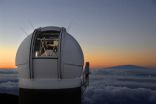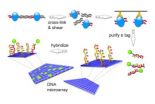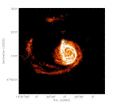(Press-News.org) In the outer reaches of our solar system lies a mysterious region far more remote and difficult to explore than the Australian outback. It remains the only part of our solar system not visited by spacecraft. Called the Kuiper Belt, this area beyond Neptune is home to the dwarf planets Pluto, Eris, Makemake, and Haumea. It also harbors thousands of smaller objects that form a second, icy asteroid belt (or more appropriately, comet belt). In this realm of perpetual twilight, the distant sun looks like just another bright star.
A new telescope has begun to virtually explore the solar system outback, and already is scoring discoveries. The Panoramic Survey Telescope & Rapid Response System (Pan-STARRS) PS1 telescope has found ten Kuiper Belt residents. Based on their brightnesses, the newfound objects range in size from 180 to 300 miles (300 to 500 km).
"We're excited that Pan-STARRS is beginning to find these objects," said Smithsonian astronomer Matthew Holman, who leads the Pan-STARRS-1 Outer Solar System Key Project.
"It marks the tip of the iceberg for future Pan-STARRS discoveries," he added.
Holman presented the findings in a press conference at the 217th meeting of the American Astronomical Society.
The Outer Solar System Key Project is part of a larger survey to which 60 percent of Pan-STARRS telescope time will be devoted. Over the course of the coming months and years, PS1 will repeatedly survey the full sky that is visible from its location on Haleakala, spotting objects as faint as magnitude 23 (10 million times fainter than visible to the unaided eye). "The survey is expected to find a whole range of objects from small, nearby asteroids to possibly more dwarf planets," stated Harvard astronomer Pavlos Protopapas
"By the end of the survey, we'll have an essentially complete census of everything brighter than the survey's limiting magnitude," said Holman. This corresponds to Kuiper Belt Objects about 180 miles in diameter or larger.
"Pan-STARRS-1 offers us a remarkable opportunity to study the outer solar system in unprecedented detail," said team member Ying-Tung Chen, a graduate student at the National Central University of Taiwan.
Pan-STARRS will allow planetary astronomers to locate many new Kuiper Belt Objects and characterize their orbits. This will provide a firmer understanding of the structure, dynamics, and evolution of the outer solar system. Pan-STARRS is also likely to be a productive tool for discovering new comets.
Pan-STARRS-1 is a 1.8-meter (71-inch) telescope featuring the world's largest digital camera -- a 1.4-gigapixel (1,400-megapixel) monster that can photograph an area of the sky as large as 36 full moons in a single exposure. PS1 became fully operational in June 2010.
INFORMATION:
New telescope is exploring solar system 'outback'
2011-01-14
ELSE PRESS RELEASES FROM THIS DATE:
Deep genomics
2011-01-14
In 2003, the year a complete draft of the human genome was released, the U.S. National Human Genome Research Institute launched the ENCODE project (ENCyclopedia of DNA Elements), to develop an encyclopedia of the epigenome, that is, of all of the many factors that can change the expression of the genes without changing the genes.
Four years later, the National Institutes of Health funded modENCODE (the Model Organism ENCylopedia of DNA Elements) to work out the epigenomes of two model organisms: the fruit fly Drosophila melanogaster, lurker among rotten bananas, and the ...
Why coffee protects against diabetes
2011-01-14
Coffee, that morning elixir, may give us an early jump-start to the day, but numerous studies have shown that it also may be protective against type 2 diabetes. Yet no one has really understood why.
Now, researchers at UCLA have discovered a possible molecular mechanism behind coffee's protective effect. A protein called sex hormone–binding globulin (SHBG) regulates the biological activity of the body's sex hormones, testosterone and estrogen, which have long been thought to play a role in the development of type 2 diabetes. And coffee consumption, it turns out, increases ...
Skin provides Australia's first adult stem cells for rare genetic disease
2011-01-14
Scientists have developed Australia's first adult induced pluripotent stem cell lines using skin biopsies from patients with the rare genetic disease Friedreich Ataxia (FA).
The study was conducted by the University of Melbourne and Monash Institute of Medical Research and is published in the current online edition of the international journal Stem Cell Reviews and Reports. It is the first time adult pluripotent stem cells, known as iPS cells have been developed for a specific disease in Australia, allowing for the development of new treatments for FA and related conditions ...
Fruit fly nervous system provides new solution to fundamental computer network problem
2011-01-14
PITTSBURGH—The fruit fly has evolved a method for arranging the tiny, hair-like structures it uses to feel and hear the world that's so efficient a team of scientists in Israel and at Carnegie Mellon University says it could be used to more effectively deploy wireless sensor networks and other distributed computing applications.
With a minimum of communication and without advance knowledge of how they are connected with each other, the cells in the fly's developing nervous system manage to organize themselves so that a small number of cells serve as leaders that provide ...
GM chickens that don't transmit bird flu developed
2011-01-14
Chickens genetically modified to prevent them spreading bird flu have been produced by researchers at the Universities of Cambridge and Edinburgh.
The scientists have successfully developed genetically modified (transgenic) chickens that do not transmit avian influenza virus to other chickens with which they are in contact. This genetic modification has the potential to stop bird flu outbreaks spreading within poultry flocks. This would not only protect the health of domestic poultry but could also reduce the risk of bird flu epidemics leading to new flu virus epidemics ...
Overexpression of repetitive DNA sequences discovered in common tumor cells
2011-01-14
Massachusetts General Hospital (MGH) Cancer Center researchers have discovered a previously unknown feature of common tumor cells – massive overexpression of certain DNA sequences that do not code for proteins. These DNA sequences – called satellite repeats – have been studied for their role in chromosomal structure but previously were not suspected of having a role in cancer. The report will appear in the journal Science and is receiving early online release.
"Satellite repeats make up a large part of our genome but had been thought to be inactive," explains David ...
When a kidney transplant fails, home-based dialysis is an option
2011-01-14
Patients returning to dialysis after kidney transplant failure present unique challenges compared with other dialysis patients: they have been exposed to very powerful immunosuppressive medications and have been on dialysis for a longer period of time than other dialysis patients. This puts them at particularly high risk for various complications and death. According to a study appearing in an upcoming issue of the Clinical Journal of the American Society Nephrology (CJASN), despite complications, these patients can choose to undergo dialysis in the comfort of their own ...
Forget Planet X! New technique could pinpoint Galaxy X
2011-01-14
Planet X, an often-sought 10th planet, is so far a no-show, but Sukanya Chakrabarti has high hopes for finding what might be called Galaxy X – a dwarf galaxy that she predicts orbits our Milky Way Galaxy.
Many large galaxies, such as the Milky Way, are thought to have lots of satellite galaxies too dim to see. They are dominated by "dark matter," which astronomers say makes up 85 percent of all matter in the universe but so far remains undetected.
Chakrabarti, a post-doctoral fellow and theoretical astronomer at the University of California, Berkeley, has developed ...
Writing about worries eases anxiety and improves test performance
2011-01-14
Students can combat test anxiety and improve performance by writing about their worries immediately before the exam begins, according to a University of Chicago study published Friday in the journal Science.
Researchers found that students who were prone to test anxiety improved their high-stakes test scores by nearly one grade point after they were given 10 minutes to write about what was causing them fear, according to the article, "Writing about Testing Boosts Exam Performance in the Classroom." The article appears in the Jan. 14 issue of Science and is based on research ...
A pounding heart may be dangerous for some kidney patients
2011-01-14
Among older adults with a recent heart attack (myocardial infarction), those with lower levels of kidney function are less likely to take their medications as prescribed, according to a study appearing in an upcoming issue of the Clinical Journal of the American Society of Nephrology (CJASN).
"Several types of medications have proven benefit for preventing recurrent heart attacks, yet only about half of people with heart disease take their medications correctly," comments Wolfgang C. Winkelmayer, MD, ScD (Stanford University School of Medicine, Palo Alto, CA). "Adherence ...


